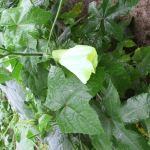| Common Name: |
Ambrette |
| Other Names: |
Muskseed, Musk Mallow |
| Botanical Name: |
Abelmoschus moschatus syn Hibiscus abelmoschus |
| Genus: |
Abelmoschus. |
| Family: |
Malvaceae |
| Cultivation: |
Grow in rich, well drained soil in sun. Pinch out the growing tips of young plants to encourage bushiness. In spring cut back plants grown as perennials to 15 cm (6 in). Plants grown under cover may suffer from whitefly. |
| Propagation: |
By seed, sown in spring at 24-27°C (75-81°F); also by semi-ripe cuttings in summer. |
| Harvest: |
Folliage and pods are picked when young and tender, and flowers as they open, and used fresh. Bark and roots are harvested as required and processed to extract fiber and mucilage. Fruits are cut as they begin to ripen and dried until the seeds are shed. Seeds are stored away from other commodities to avoid persistent musk odor, and are distilled for oil. They are also steeped in vegetable oil for external use. |
| Native Region: |
Tropical Asia |
| Height: |
1-2m (3-6ft) |
| Width: |
45-90cm (18-36in) |
| Varieties: |
Oriental Pink
Description: Red-pink, white-centered flowers, 6-8 cm (2½-3in) across.
Height: 38-45cm (15-18in).
Width: 23-30cm (9-12in). |
| Hardiness: |
Min. 5°C (41°F) |
| Parts Used: |
Leaves, bark, roots, flowers, pods, seeds, oil. |
| Properties: |
An aromatic, stimulant herb that relaxes spasms, especially in the digestive tract. It is also insecticidal and is regarded as an aphrodisiac. |
| Medicinal Uses: |
Internally as a digestive and breath freshener (seeds). Externally for cramps, poor circulation, and aching joints, and in aromatherapy for anxiety and depression (oil). |
| Culinary Uses: |
Young leaves and new shoots are eaten as vegetables. Leaves are used to clarify sugar. Unripe pods, known as "musk okra", are eaten as a vegetable. Seeds flavor coffee, liqueurs, and breads and are an ingredient of the N. African spice mix, ras-el-hanout. |
| Economic Uses: |
Bark is processed into fiber. Root mucilage provides sizing for paper. Flowers are used for flavoring tobacco. Oil is used in food flavoring, vermouth, bitters, perfumery, and cosmetics as a musk substitute; it is free from the fecal note sometimes present in animal musk. Formerly a common ingredient in after-shave lotions but now largely discontinued because it causes photosensitization. |
| Bibliography: |
Encyclopedia of Herbs by Deni Brown Copyright © 1995, 2001 Dorling Kindersley Limited. pg 96.
|
